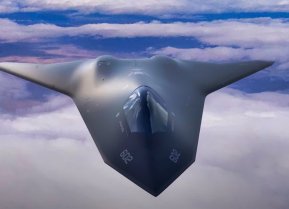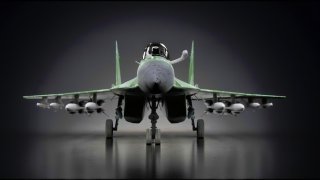Ukraine's MiG-29 Fighters: Old Soviet Jets Making a Big Impact
The Mikoyan MiG-29 has played a crucial role in Ukraine's defense against Russia despite being outdated. Originally developed in the 1970s as a Soviet fourth-generation fighter, it has been used to contest airspace and mitigate Russian air superiority.
Summary: The Mikoyan MiG-29 has played a crucial role in Ukraine's defense against Russia despite being outdated.
-Originally developed in the 1970s as a Soviet fourth-generation fighter, it has been used to contest airspace and mitigate Russian air superiority.
-Ukraine's fleet, supplemented by donations from Poland and Slovakia, has proven effective but will be eventually replaced by American-made F-16s.
-The MiG-29 features notable agility and armament capabilities, though it lacks modern advancements found in contemporary Western fighters.
MiG-29 Fighters: Ukraine's Air Superiority Solution Amidst Russian Invasion
One of the early surprises from Russia’s invasion of Ukraine was Moscow’s failure to secure the airspace above Ukraine. That failure condemned Russia to a multi-year ground-based slog. Even today, in year three of the conflict, Ukrainian airspace is contested despite Russian advantages in the air.
One of the tools Ukraine has relied on to contest their airspace and mitigate the Russian advantage is the Mikoyan MiG-29 fighter. Ukraine’s fleet of MiG-29s is not a perfect answer – many of the airframes are outdated and derelict – but the Cold War-era jet has helped just enough.Known to NATO as the Fulcrum, the MiG-29 is a fourth-generation Soviet fighter that was developed in the 1970s. Built for air superiority missions, the Fulcrum was the Soviet answer to American fourth-generation air superiority fighters like the F-15 Eagle and F-16 Fighting Falcon. The Soviets found themselves needing to field a more competitive aircraft, and the MiG-29 answered the call. The MiG-29 features a mid-mounted sweep-wing. Leading-edge root extensions, which sweep at 40 degrees, make it visually distinct, and the two vertical stabilizers are noticeably wide-set.
Unlike so many fourth-generation aircraft, the MiG-29 does not feature a fly-by-wire control system. It is still an agile aircraft, capable of sustaining impressive turn rates and high angles of attack.
For propulsion, the MiG-29 relies on two Klimov RD-33 turbofan engines, capable of providing 11,200 pounds of thrust when dry, or 18.300 pounds of thrust when operated with afterburner. Like the vertical stabilizers, the engines are widely spaced. The space between the engines increases the surface area of the rear fuselage and provides additional lift, which reduces the load on the wing surfaces and in effect improves the jet’s maneuverability.
The MiG-29 does not have great fuel capacity. The jet’s six internal tanks consume fuel quickly. Without external fuel tanks, the MiG-29 has an operational range of 930 miles. With the external fuel tanks added, the range improves to 1,300 miles.
Naturally, the MiG-29 was outfitted with a healthy array of armament to assist in the air superiority (and later multirole) mission profile. In the port wing root, the MiG-29 features a GSh-30-1.20mm cannon that holds 100 rounds. Beneath each wing, the MiG-29 has three pylons that can be used for the aforementioned external fuel tanks, or, missiles, bombs, and rockets.
Of course, the MiG-29 has become outdated since its initial release in the 1970s. American fifth-generation fighters like the F-22 and F-35 are significantly more advanced than the MiG-29, and even American fourth-generation fighters like the F-15 and F-16 have been upgraded to the point where they can be considered “fourth-generation-plus” fighters. So the MiG-29s that Ukraine has taken out of storage, or received from charitable neighbors like Poland and Slovakia, are not exactly cutting-edge aircraft. But they’re better than nothing.
The MiG-29 in Ukraine
There is some irony in the Ukrainians using Soviet aircraft to defend against Putin’s invasion.
“The Ukrainian air force closely guards the details of its front-line strength,” David Axe reported for Forbes. ‘It’s possible that, when Russia widened its war on Ukraine…the Ukrainian air arm had just 50 or so flyable MiG-29s, all of which Kyiv inherited from Moscow as the Soviet Union collapsed in 1991.”
Ukraine has supplemented their MiG-29 force with imports – 20 or so from Poland and about 10 from Slovakia, according to Axe. The jets from Poland are in better shape than their Slovakian counterparts and came with a slew of upgrades that should improve the jet’s effectiveness.
“The Polish jets, which Warsaw is replacing with a mix of F-16s and F-35s, come with extensive upgrades: modern transponders, GPS and radar-warning receivers; NATO-style radios; new avionics and cockpit displays and – perhaps most significantly – a MIL STD 1552 digital data bus that should allow the jets to deploy GPS-guided munitions,” Axe added.
The MiG-29 will be pushed down in the hierarchy of Ukrainian fighter jets once American-made F-16s arrive in June or July. Ukraine has been pressuring the West for F-16s since the early days of the conflict, with relief finally on the way. Ukrainian pilots and maintenance crews have already begun training with the F-16, in hopes of being effective the day the jets are made available.
About the Author: Harrison Kass
Harrison Kass is a defense and national security writer with over 1,000 total pieces on issues involving global affairs. An attorney, pilot, guitarist, and minor pro hockey player, Harrison joined the US Air Force as a Pilot Trainee but was medically discharged. Harrison holds a BA from Lake Forest College, a JD from the University of Oregon, and an MA from New York University. Harrison listens to Dokken.
Image Credit: Shutterstock.


